Stuff
On Wednesday morning we headed down to the lake in thick fog and photographed a female Anhinga drying her wings on the perch for about 45 minutes as the sun broke through.
Here is some of the other stuff that happened on Wednesday:
1-I had the roof of my house pressure washed: $300.00.
2-I agreed to have the many bad seams on the metal roof repaired and to have the roof coated with a ceramic sealant: $7,000.00.
3- (After a flat on Saturday morning) I had four new tires put on my Sequoia, new brake linings, and balancing and alignment: $752.53.
I swam a leisurely half mile.
Loving what is 🙂
On Wednesday evening we headed down to the lake to find a grackle on the perch. NG. We drove around a bit and returned to check the perch one last time as the western sky colored up. The Anhinga was back. I got all set up and made a single frame at 840. As the bird leaned forward I switched from Left Large Zone to Center Large Zone and got two nice frames of the take-off. 🙂
|
|
Amazing 5D Mark IV Sale! |
5D Mark IV Still on Sale!
Right now you can purchase a Canon EOS 5D Mark IV with the BG-E20 Battery Grip for the crazy low price of $3199. I am not sure how long this Black Friday sale will last …
Blog regular Bill Hill was so excited when he read of this sale that he forgot to use my affiliate link. 🙂 He wrote, “I still think the 5D Mark IV sale is is too good to be true. I will believe it when it arrives. Thanks for the heads up.
Note: Bill went for the one with the free battery grip and the free Canon PIXMA PRO-100 Wireless Professional Inkjet Photo Printer.
The Streak
Today makes one hundred thirty-two days in a row with a new educational blog post! This one took about 90 minutes to prepare. With all of my upcoming free time (or not …), the plan right now is to break the current record streak of 480 … Good health and good internet connections willing.
Booking.Com
Booking.Com came through for me twice again recently with both the DeSoto Fall IPT and next July’s UK Puffins, Gannets, and Bempton Pre-trip room reservations. And all the rates were great. If you’d like to give Booking.Com a shot, click here and you will earn a $25 reward. Thanks to the many who have already tried and used this great service.


Gear Questions and Advice
Too many folks attending BAA IPTs and dozens of folks whom I see in the field, and on BPN, are–out of ignorance–using the wrong gear especially when it comes to tripods and more especially, tripod heads… Please know that I am always glad to answer your gear questions via e-mail. Those might include system, camera body, accessory, and lens choices and decisions.
|
|
|
This image was created down by the lake near my home at Indian Lake Estates, FL on the morning of Saturday, December 2, 2017, just about 24 hours after Anita North and I had erected the perch. I used the Induro GIT304L Grand Series 3 Stealth Carbon Fiber Tripod/Mongoose M3.6-mounted Canon EF 600mm f/4L IS II USM lens, the Canon Extender EF 2X III, and my favorite Osprey photography camera body, the Canon EOS 5D Mark IV. ISO 400. Evaluative metering +2/3 stop as framed: 1/800 sec. at f/11 in Manual mode. AWB. 8:27am on a clear morning. LensAlign/FocusTune micro-adjustment: extrapolated to -10. Upper Large Zone/AI Servo/Shutter Button AF was active at the moment of exposure. The system selected a cluster of three AF point, one of which fell squarely on the bird’s eye. The other two were on the bird’s upper breast and the top of the back. Image #1: Osprey wing stretch |
The First Osprey
It only took us about 45 minutes to set the perch and tie it off. Then we took a short ride to see how the vultures were doing and make a few crane images. Then we went back to check out new perch. It was finely adorned by the lovely Osprey that you see above. Working behind some chest high bushes, we set up, me working at 12000mm, Anita at 1000mm. With a minute the bird did a beautiful wing stretch. Anita made some very fine horizontals.
|
|
|
This image was created down by the lake near my home at Indian Lake Estates, FL on the morning of Saturday, December 2, 2017 by Anita North. She used the Induro GIT304L Grand Series 3 Stealth Carbon Fiber Tripod/Wimberley-mounted Canon EF 500mm f/4L IS II USM lens, the Canon Extender EF 2X III, and the Canon EOS 5D Mark IV. ISO 800. Evaluative metering +2/3 stop as framed: 1/1250 sec. at f/11 in Manual mode. AWB. 8:27am on a clear morning. Two rows up and three to the left of the center AF point/Spot AF/AI Servo/Shutter Button AF was active at the moment of exposure. The selected Af point was on the bird’s upper breast. Image #2: Osprey wing stretch
|
Anita’s Osprey Wingstretch
Anita was just to my left for the wingstretch working with the 500mm and the 2X III TC. I loved her RAW file. Even as a beginner Anita was able to make sharp images and once she began working with both teleconverters she continued to excel at making sharp images. She processed the image using a technique that someone taught (or mis-taught) her and completely ruined the sky. I grabbed the RAW and converted it in DPP 4 (as she had). In Photoshop I moved the bird left in the frame using techniques from APTATS II and then cropped a bit from the right and above. Total time in Photoshop: 40 seconds. I chose to leave the tiny bright scars at the bend of the perch so that you can see what I do with each perch image. My repairs are done using a series of small warped Quick Masks that are refined with the addition of Regular Layer masks. Then I use the Patch Tool and the Clone Stamp Tool to tidy things up if needed. Anita has improved her techniques by light years while attending several IPTs over the past few years. She needs to work more on her post-processing skills.
General post processing advice for all: keep things simple. Convert your Canon images in DPP 4 and then follow the simple directions for optimizing your images in the BIRDS AS ART Current Workflow e-Guide (Digital Basics II). KISS 🙂
|
|
|
This image was created down by the lake near my home at Indian Lake Estates, FL on the morning of Saturday, December 2, 2017, just about 24 hours after Anita North and I had erected the perch. I used the Induro GIT304L Grand Series 3 Stealth Carbon Fiber Tripod/Mongoose M3.6-mounted Canon EF 600mm f/4L IS II USM lens, the Canon Extender EF 2X III, and my favorite Osprey photography camera body, the Canon EOS 5D Mark IV. ISO 400. Evaluative metering +2/3 stop as framed: 1/800 sec. at f/11 in Manual mode. AWB. 8:27am on a clear morning. LensAlign/FocusTune micro-adjustment: extrapolated to -10. Upper Large Zone/AI Servo/Shutter Button AF was active at the moment of exposure. The system selected a cluster of three AF points, one of which fell squarely on the bird’s eye. The other two were on the bird’s upper breast and the top of the back. Image #3: Osprey classic side view |
The Second Osprey
Anita went down to the lake that evening just before sunset while I opted to take it easy 🙁 Big mistake; she made some wonderful silhouettes of an Anhinga doing all sorts of things. I will share those with you here soon. The next morning dawned clear and beautiful. The next morning we checked the perch right after sunrise but it was empty. We made a wiggle and when we return the same bird graced the perch. With a different wind direction we were afforded a different basic pose.
Your Favorite
Please take a moment to let us know which of today’s featured images you like best. Be sure to let us know your reasons.
|
|
2017 in San Diego was a very good year …. |
2018 San Diego 3 1/2-DAY BIRDS AS ART IPT #2: Sunday, JAN 28 thru and including the morning session on Wednesday, JAN 31, 2018 and a free morning session the day before the IPT starts: 3 1/2 days (+1/2!): $1699. Limit: 8: Openings: 7.
Meet and Greet at 6:30pm on the evening before the IPT begins; Saturday, Jan 27, 2018.
San Diego IPT #2: Shorter and Less Expensive!
Please remember: I go with one.
Join me in San Diego near the end of January to photograph the spectacular breeding plumage Brown Pelicans with their fire-engine red and olive green bill pouches; Brandt’s (usually nesting and displaying) and Double-crested Cormorants; breeding plumage Ring-necked Duck; other duck species possible including Lesser Scaup, Redhead, Wood Duck and Surf Scoter; a variety of gulls including Western, California, and the gorgeous Heerman’s, all in full breeding plumage; shorebirds including Marbled Godwit, Whimbrel, Willet, Sanderling and Black-bellied Plover; many others possible including Least, Western, and Spotted Sandpiper, Black and Ruddy Turnstone, Semipalmated Plover, and Surfbird; Harbor Seal (depending on the current regulations) and California Sea Lion; and Bird of Paradise flowers. And as you can see by studying the two IPT cards there are some nice bird-scape and landscape opportunities as well. Please note: formerly dependable, both Wood Duck and Marbled Godwit have been declining at their usual locations for the past two years …
|
San Diego offers a wealth of very attractive natural history subjects. With annual visits spanning more than three decades I have lot of experience there…. |
With gorgeous subjects just sitting there waiting to have their pictures taken, photographing the pelicans on the cliffs is about as easy as nature photography gets. With the winds from the east almost every morning there is usually some excellent flight photography. And the pelicans are almost always doing something interesting: preening, scratching, bill pouch cleaning, or squabbling. And then there are those crazy head throws that are thought to be a form of intra-flock communication. You can do most of your photography with an 80- or 100-400 lens …
Did I mention that there are wealth of great birds and natural history subjects in San Diego in winter?
|
Though the pelicans will be the stars of the show on this IPT there will be many other handsome and captivating subjects in wonderful settings. |
The San Diego Details
This IPT will include four 3 1/2 hour morning photo sessions, three 2 1/2 hour afternoon photo sessions, three lunches, and after-lunch image review and Photoshop sessions. To ensure early starts, breakfasts will be your responsibility. Dinners are on your own so that we can get some sleep.
A $599 non-refundable deposit is required to hold your slot for this IPT. You can send a check (made out to “Arthur Morris) to us at BIRDS AS ART, PO Box 7245, Indian Lake Estates, FL, 33855. Or call Jim or Jennifer at the office with a credit card at 863-692-0906. Your balance is payable only by check. Please print, complete, and sign the form that is linked to here and shoot it to us along with your deposit check. If you register by phone, please print, complete and sign the form as noted above and either mail it to us or e-mail the scan. If you have any questions, please feel free to contact me via e-mail.
If In Doubt …
If in doubt about using the BAA B&H affiliate link correctly, you can always start your search by clicking here. Please note that the tracking is invisible. Web orders only. Please, however, remember to shoot me your receipt via e-mail.




Please Remember to use my Affiliate Links and to Visit the New BAA Online Store 🙂
To show your appreciation for my continuing efforts here, we ask, as always, that you get in the habit of using my B&H affiliate links on the right side of the blog for all of your photo and electronics purchases. Please check the availability of all photographic accessories in the New BIRDS AS ART Online Store, especially the Mongoose M3.6 tripod head, Wimberley lens plates, Delkin flash cards and accessories, and LensCoat stuff.
As always, we sell only what I have used, have tested, and can depend on. We will not sell you junk. We know what you need to make creating great images easy and fun. And please remember that I am always glad to answer your gear questions via e-mail.
I would of course appreciate your using our B&H affiliate links for all of your major gear, video, and electronic purchases. For the photographic stuff mentioned in the paragraph above, and for everything else in the new store, we, meaning BAA, would of course greatly appreciate your business. Here is a huge thank you to the many who have been using our links on a regular basis and those who will be visiting the New BIRDS AS ART Online Store as well.
Be sure to like and follow BAA on Facebook by clicking on the logo link upper right. Tanks a stack.
Typos
In all blog posts and Bulletins, feel free to e-mail or to leave a comment regarding any typos or errors. Just be right :).

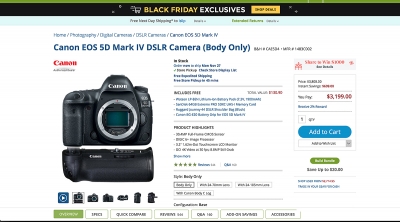
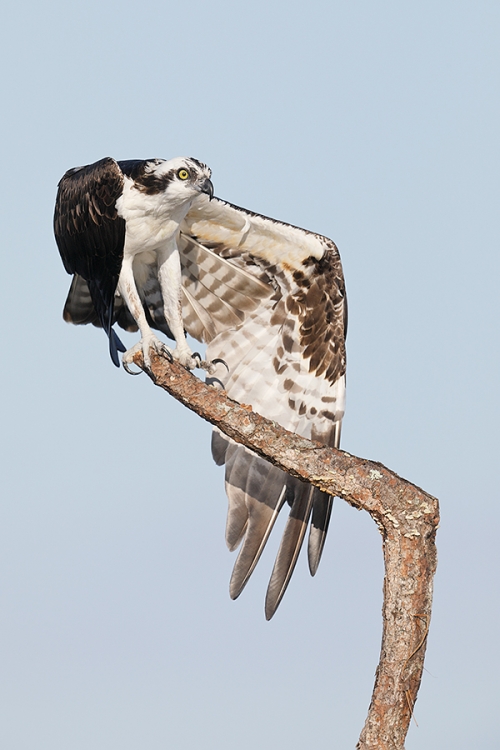
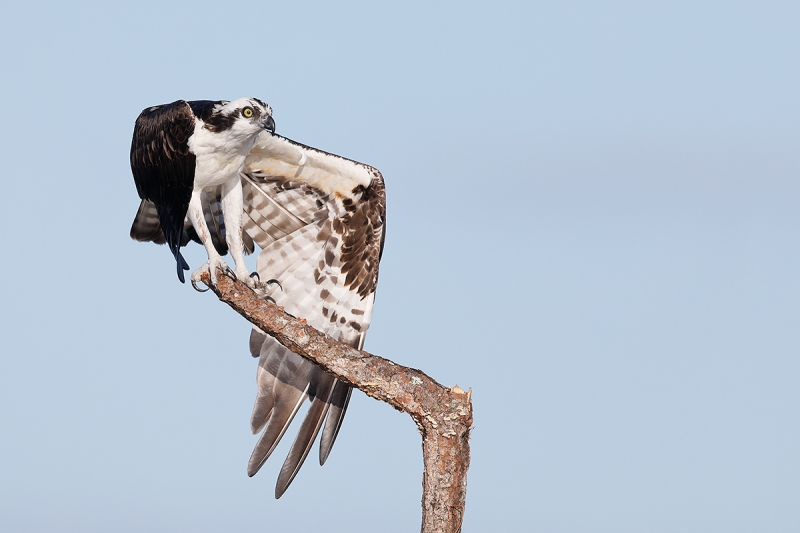
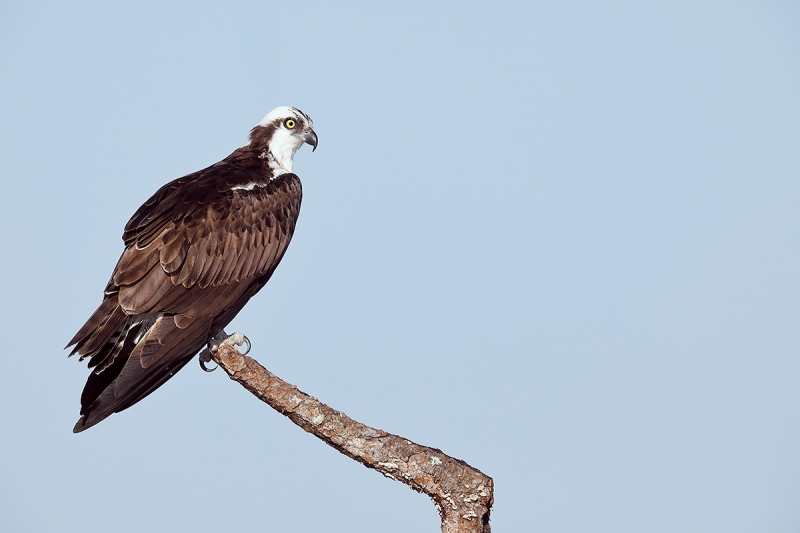
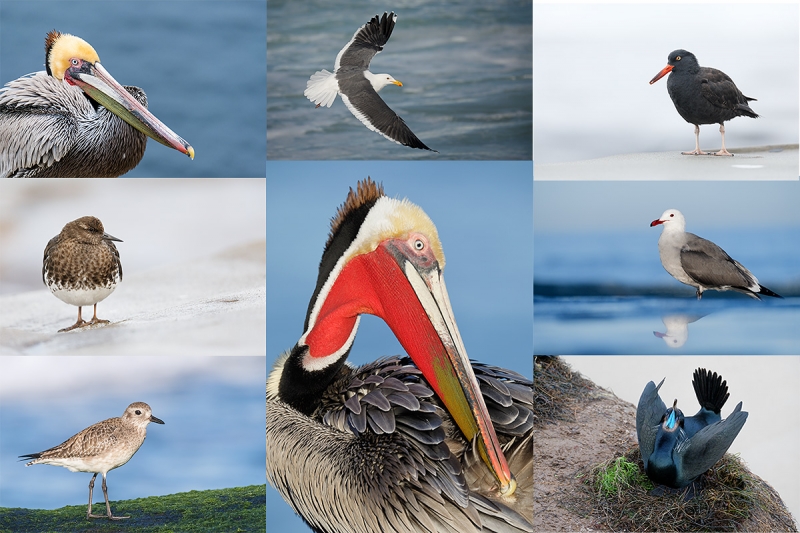















Image 1.
Rarely seen is the “braking” effect of the birds wings. The grab with the claws capture is also rarely seen.
The implied action and movement to the perch is terrific.
Hey Arthur, Image #3 is my favorite. Love the classic pose and the light blue background. have fun at the perch.
Beautiful images…glad to see the perch is working out and can’t wait to see Anita’s Anhinga silhouettes…say Hi to Anita for me 🙂
Hello Artie,
Greetings from Singapore.
Howdy.
In the Osprey image, you wrote following:
“Upper Large Zone/AI Servo/Shutter Button AF was active at the moment of exposure. The system selected a cluster of three AF points, one of which fell squarely on the bird’s eye. The other two were on the bird’s upper breast and the top of the back”.
That is correct.
Based on this it would seem you are using may be 51 points or Group focus mode. Is that correct?
I am confused by your non-Canon terms 🙂 I am not using Canon’s 65-point AF. I am using one of the three Large Zones …
For stationary bird on a perch, I would usually use AF-Continous Single (AF-C S) with my Nikon D810.
First off, I think that there is no such thing as AF-C-S … Continuous in Nikon is the same as AI Servo (tracking) AF in Canon. AF-S on the other hand equates to One-Shot in Canon. (If I am correct) the problem with using a locked focus point on a “stationary” bird is that stationary birds are rarely stationary … Unless they are sleeping, birds are almost always moving or shifting their heads or their positions.
Please can you explain benefits of using multiple focus points?
We are getting deeper in trouble here 🙂 I use AI Servo AF so that the system tracks the bird and focuses accurately (we hope) even when a perched or resting bird is moving only a bit … The question of using multiple AF points has nothing to do with AI Servo or One-Shot in Canon or AF-C or AF-S in Nikon lingo. As I stress often here on the blog the big advantage of using Large Zone AF is that you are afforded much more compositional freedom than if you are using one AF point, AF Expand (usually five AF points), or AF Surround (usually nine AF points). I know that Nikon offers similar options but I do not know the terminology …
Do you use this method even when background is not sky but say trees at some distance such that there is possibility it will take longer to acquire focus on the subject as the camera may focus on the background with stronger contrast.
I rarely use Large Zone AF for flight photography but I will use Large Zone AF to photograph birds in action on the ground or in the water. There will be at least two examples of that in the coming weeks.
Will appreciate if you can clarify this point.
I did my best but I am pretty sure that some of your points are confused … If you can refine your question or questions I would be glad to do my best once again.
with love, artie
The first image is my favorite. The perch leads my eye into the image and the curvature of the wing stretch takes my eye to the birds face. Very nice.
Very impressive images. Good use of that perch. Probably a typo, but did you really manage to shoot the first Osprey at 12000mm LOL.